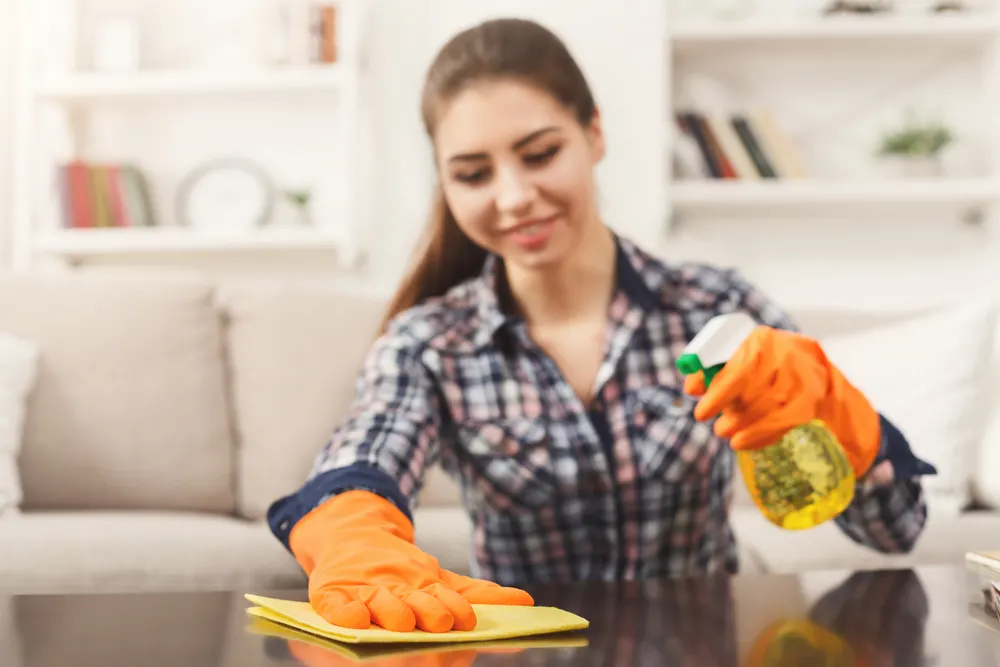IKEA has managed to carve a niche for itself that sometimes causes people to view its products as if they fall into a category of their own. If you’re used to doing one thing with your furniture but you just bought a new piece from IKEA, you may be wondering if it’s alright to treat it the same way—and that may include cleaning it with a product you already have, like Pledge.
Using Pledge on your IKEA furniture may be fine, but this is not guaranteed. In fact, Pledge has some drawbacks of its own, no matter what brand of furniture it is used on.

It’s probably safe to use Pledge on IKEA furniture, but IKEA do not recommend any polishers or cleaners. Rather use a dry or slightly damp cloth. If Pledge is to be used, test on a cheaper or older piece and in an inconspicuous area. Don’t risk use on solid wood furniture.
Pledge Is Not an IKEA-Recommended Product
IKEA does not actually recommend or discourage the use of furniture polishes like Pledge. In fact, the company only recommends the use of simple dusting techniques involving a cloth for cleaning your furniture and keeping it in good condition.
Now, Pledge has been a popular product for cleaning and finishing furniture for many years, but it’s reasonable to want to double-check that it’s okay to use on your new IKEA furniture too. After all, better to be safe than sorry.
While it is likely alright to use Pledge on your IKEA products, there are a few reasons why it may not be your best option.
Drawbacks of Using Pledge
Even polishes like Pledge that are popular and commonly used do have potential drawbacks, which could be part of why IKEA doesn’t condone the use of cleaning or polishing products.
For example, Pledge is known for leaving behind a glossy shine. This shine is created thanks to a thin layer of silicone that is deposited onto the surface of the furniture.
Over time, this silicone can build up and create a layer of what is commonly referred to as “silicone contamination.”
Despite the ominous-sounding name, silicone contamination is not generally harmful to your furniture, though it can cause problems down the line by creating a buildup of product that makes repairs or refinishing difficult.
If not applied evenly or if touched before dry, it may also leave smudges behind on the surface of your furniture.
Pledge Might Not Damage the Furniture
As established, Pledge leaves behind a thin layer of silicone. This is actually why it is considered a polish and not a cleaner, as it does not technically “remove” anything from, but instead adds to the surface of your furniture.
While this makes damage unlikely, it’s generally a good idea to err on the side of caution. As IKEA doesn’t recommend any products, it’s probably safest to avoid them.
However, you are the owner of the furniture, and the decision is yours. You probably won’t have any regrets about choosing to use Pledge, since it’s not likely to cause harm. However, it’s a good idea to at least perform a test first.
If you have an IKEA product on the cheaper end that you wouldn’t mind losing, try using Pledge on that piece first. If your furniture is more expensive and you want to test it, try finding a small, inconspicuous area to try out.
Don’t Risk It With Solid Wood Furniture
While IKEA’s products are mostly made from particleboard, they do have solid wood furniture as well. Solid wood is not only more expensive, but it is more durable and longer-lasting.
Since solid wood furniture is likely to last a long time, it may need to be resurfaced or repaired some years down the line in order to maintain its integrity and aesthetic.
As mentioned previously, silicone contamination makes repairs and refinishing difficult. This is because it can build up in a manner that creates small craters called “fish eyes” that cause the finish to apply unevenly and unattractively.
Not all refinishers know how to deal with fish eye, and it adds extra work for those who do. To make things easier for both yourself and whoever might perform refinishing work on your solid wood furniture, it’s probably best not to use products like Pledge that contain silicone on your solid wood pieces.

IKEA-Recommended Cleaning of Wood Furniture
Since IKEA doesn’t suggest the use of cleaning products on their wooden furniture, let’s look at what they do recommend.
First, you should dust your furniture at least once a week, though it is suggested to dust daily if possible. When dusting, be careful to avoid rough rubbing or scratching, and make sure to clean in the direction of the grain to avoid wear or catching.
In order to dust your furniture, it is recommended to use a soft, dry cloth. However, IKEA notes that a damp cloth is not likely to cause harm to wooden furniture, should you choose to use one.
With that said, if you choose to dust with a damp cloth, be sure to quickly wipe away remaining moisture with a dry second cloth to limit exposure to moisture.
That covers basic cleaning, but IKEA also offers a few additional tips for keeping your furniture in pristine condition. By following them, you can help make your furniture last longer.
While no specific cleaning products are suggested, it is specifically stated that ammonia-based cleaners should be avoided, as they will wear down the surface of your wood.
Heavy exposure to sunlight can also alter the color and shine of your wood, so be sure to place your furniture with that in mind if you want to maintain its current condition.
Sources
https://www.ikea.com/es/en/ideas/como-limpiar-muebles-de-madera-pub4b2186b0
https://www.woodshopnews.com/columns-blogs/four-methods-to-prevent-fish-eye

